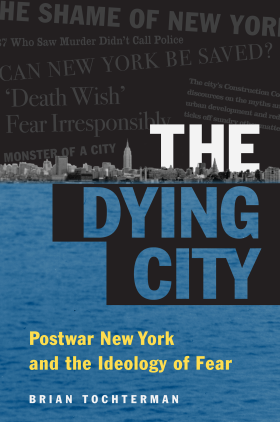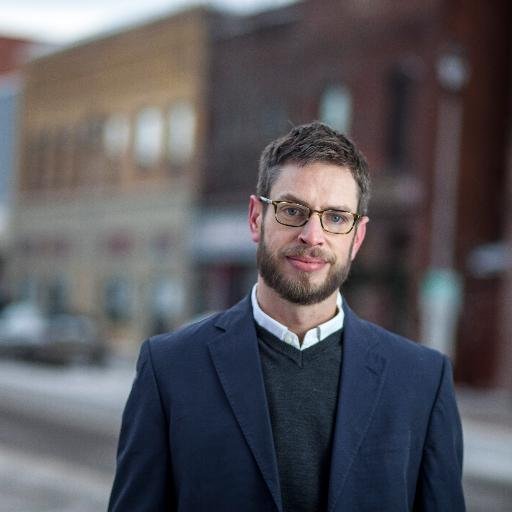The Cultural Origins of the Urban Crisis: An Interview with Brian L. Tochterman
Today on Gotham, editor Nick Juravich interviews Brian L. Tochterman about his new book, The Dying City: Postwar New York and the Ideology of Fear, about the competing narratives that shaped the city after World War II, in the age of mass suburbanization and deindustrialization.
For readers who haven't encountered the book yet, how did you come to the topic? As a cultural historian, was there a particular book or film that touched off your inquiry?
The Dying City combines a host of research and personal interests. Its scholarly origins go back to two seminar courses at the University of Minnesota, one on the “urban crisis” and another on cold war culture, taught by Professors Kevin P. Murphy and Elaine Tyler May respectively. I arrived intending to study early twentieth century urban development, but the course material really got me excited about the post-World War II period. May’s Homeward Bound made passing mention of pulp-writer Mickey Spillane as did K.A. Cuordileone’s Manhood and American Political Culture in the Cold War. Cuordileone’s way of analyzing political tracts, mass-market texts and popular criticism was particularly significant as I turned toward cultural history. As a doctoral student it was probably the most influential monograph I read outside of the postwar metropolitan historiography. Beyond those brief citations, I found that Spillane was understudied and from there I dove into his work.
Coming to a history program from urban planning / studies I carried with me the work of Mike Davis, whose style of writing was something I always aspired to but have yet to replicate. I had a long-time personal interest in prewar pulp fiction and film noir, and clearly those pastimes shine through in a couple of chapters. But like Davis in City of Quartz, if I may summarize and simplify his work, I was interested in the way in which the noir ethos seeps into other parts of the city’s image. Finding the echoes of Spillane, were they to exist, became my primary research project, and, as the final product suggests, they were there.
Outside of the classroom and archive, I have always been drawn to the sensational coverage of crime and violence, both true and in fictional representation. I was also drawn to the idea of New York City as this exceptional place. When I worked for the Parks Department prior to graduate school, I was able to develop a connection with the city as a whole — all the boroughs, neighborhoods and communities — that transcended the experience of even lifetime New Yorkers. And as a non-native New Yorker I was very familiar with the dangerous image of the city in the Midwestern consciousness, an image that was not reflected in the reality I found there.
When I left the city, the opportunity to reconnect through research had a certain lure. The challenge, as I suspect readers of the blog will recognize, is finding something new and interesting to say about such a deeply interrogated place. And it’s my hope that The Dying City does that.
What about the rest of your source base? How did you choose the films and novels you focus on? And were there others you considered but left on the cutting room floor?
Related to my previous comment and the time period under study, a discussion of figures like Robert Moses and Jane Jacobs seemed imperative. Of course, they are subjects of a substantial historiography. “Is it possible to offer anything new?” became an anxiety-inducing question. They were active agents in change, but they were also communicators and cultural producers. Analysis of the intent and contingencies of that content appeared to be a gap even in that considerable literature. (However, Robert Caro recently noted that several hundred thousand words of Power Broker material was left on the cutting room floor, so maybe it’s in that pile of papers.)
Examining the broader world of publishing, beyond pulp fantasy, was critical. New York City was and is the home to that side of the culture industry, and magazine journalism was a significant shaper of the zeitgeist at this time. As I began exploring sources related to that realm I was struck by the number of “special” issues devoted to New York City in the late 1950s and early '60s. That’s a clear signal that something was up and that there’s a perceived market for those tales of the ailing city. As I point out in my book, even a serious intellectual outlet like Dissent sought to take advantage of this moment, publishing an issue in 1961 that marked the journal’s largest print run up to that point. The narrative of the city was changing. It wasn’t just pulp fodder anymore, and it didn’t fall easily along political lines, then or now.
I left a lot of material on the cutting room floor. Since this book is as much about the narratives of power and white privilege as it is about the power of narratives, African American and Puerto Rican sources that seek to counter established power structures, including books like Invisible Man, Down these Mean Streets, blaxploitation films and music sources galore, do not receive the kind of analysis they would receive in a broader history of New York City in this period. There’s probably a whole book in Stevie Wonder’s “Living for the City” alone.
I also made a strategic choice to focus on “homegrown” sources — critics, commentators and texts with a deep connection to New York City — to insure some integrity in the representations. Therefore I resisted simplistic panderings from afar like Hank Williams Jr.’s “Country Boy Will Survive.” Moreover, the pure number of films shot in New York in this period required me to focus on those where the persistent echoes of Necropolis were transparent. I made a choice to leave out the more satiric send-ups, like Escape from New York or Ghostbusters, even though those are some of my personal favorites.
Yes, about those terms, Necropolis and Cosmopolis. You introduce them in your introduction as a way to classify narratives about NYC in the era. How did you settle on these? And is there usefulness in considering the present with this framework?
Cosmopolis and Necropolis are labels that emerge in urban theory, and each have some connection with New York City even if the terminology isn’t well known. The former is perhaps identifiable due to the eponymous Don DeLillo novel and its film adaptation. Cosmopolis also serves as a chapter title for Ric Burns’s New York: A Documentary Film, examining the years 1919-1931 or the post-migration, pre-Depression city emerging as the central cultural force in the world. In planning theory, it constitutes Leonie Sandercock’s idyllic vision of a just, humane, multicultural community. For me the label encapsulates the cosmopolitan vision of New York rearticulated by E.B. White coming out of the depression and world war.
Necropolis, on the other hand, was a term coined by the great Scottish planning theorist, Patrick Geddes, to signify the “city of the dead.” Lewis Mumford, a Geddes disciple, highlighted the “classic danger signals” of Necropolis in The City in History (1962) by citing ancient Rome’s “suffocating” crowds, rising rents, physical decline and violent spectacle. Reading Mumford’s descriptions alongside his scathing review of Jane Jacobs’ Death and Life of Great American Cities from the same year, it was pretty clear that he saw New York City as Rome’s heir apparent.
As for New York City today, Cosmopolis reigns, at least on the surface. The city maintains a significant pull on the national and world stage, and I freely admit I felt the allure as well. Crime is down and there’s a subsequent image of safety and universal access, by which I mean there’s nary a neighborhood that hasn’t seen the forces of gentrification or will in the not-too-distant future. However, there is a class dynamic that would have been utterly foreign in the period I write about, with the exception of critics like John Cheever who complained of shrinking safe housing opportunities for upper-middle-class whites in Manhattan.
While many would hail the city of today as a success, I see it more through the lens of what Jacobs called the “self-destruction of diversity” or what writer Jeremiah Moss has termed “hyper-gentrification.” Readers of the blog are likely familiar with Moss’ chronicling of “vanishing New York,” or the people and places driven out by a largely unregulated real estate market during a period of unprecedented economic growth. These chronicles detail the loss of something authentic about New York as well as the decline of that cosmopolitan ethos. This is where the fears about Necropolis reside today, and I find them convincing.
You make a compelling case for cultural history in the book by showing how narratives of New York City's decline could (and did) become self-fulfilling prophesies, even though some of the early examples of this trope — the Spillane novels, in particular — were written at a time when the city was still, in many ways, a thriving Cosmopolis. How powerful were these narratives and imaginaries? There is, of course, a whole literature on the "Origins of the Urban Crisis," in Tom Sugrue's seminal formulation, but how should we teach and understand its cultural dimensions, in New York and other formerly great northern cities?
I would not argue that any source I examine had significant agency on its own or in a vacuum. No one was reading Mickey Spillane for the way he described “shabby blocks” or boarded-up tenements — they read him for the depictions of sex and violence. Although certain works like Death and Life of Great American Cities and Michael Harrington’s The Other America had tremendous influence in their time, particularly in the realm of policy, I am not interested solely in that initial agency. Rather my interests lie in exploring their lasting power, and that requires analysis of the content alongside concurrent voices. A simplified version of the key question: How does the power of discourse snowball? How does the representation become an image that becomes a trope that becomes a signal wielded politically? While the book has a chronological narrative, it is a genealogy of urban fear that requires some reaching backward as well.
I would never suggest that cultural urban history should replace studies of urban political economy, but it’s critical that the two are read alongside one another. For me cultural and intellectual histories are necessary for understanding how power functions and reproduces itself. As such, works by Robert Beauregard, Eric Avila and Steven Conn, among others, have been just as influential in my understanding of the history of twentieth century urban America. The kind of work I do is not going to get you into the offices of political and economic decision-making — Robert Moses did not decide to run the Lower Manhattan Expressway through the Bowery after reading in Mickey Spillane that he’d get little pushback on a “street of people without faces.” But it demonstrates how the “urban crisis” took on enough cultural weight to earn that discursive label, and highlights how fear has been deployed toward certain policy and development ends. If anything, The Dying City illustrates the contingencies and consequences of narratives and imaginaries, which is of patent import in our current political moment.
Related to this question, I'm a social historian of NYC in the 1970s, and in my own work I came across protests by the United Bronx Parents against the film "Fort Apache: The Bronx." Essentially, they argued that the film was a hit job on their neighborhoods, and helped justify neglect of them. Did you find similar protests by New Yorkers who might not have been culture-producers, but who resented or rejected the portrayal of their city as Necropolis?’
What a fascinating find; one emblematic of the perceived power of image and narrative! I suspect that film was more offensive and easier to organize around since it singled out a specific neighborhood or series of Bronx neighborhoods in the title and plot.
I do not write about any specific organized community response to the films I examine, but there is a catalogue of local backlash. Well-known film critics go on the attack, for example. Rex Reed called Midnight Cowboy“perhaps the worst indictment of the city of New York ever captured on film.” Death Wish was condemned by local reviewers as right-wing propaganda produced by tourists.
In several cases the Times and other outlets were compelled to get vox-populi impressions from New Yorkers after viewing certain crisis films. Sometimes these came across in profiles, such as when Peter Boyle expressed concern — even fearing for his own life — recalling the responses he received from locals regarding his portrayal of a hard-hat hippie-hating vigilante in Joe. Death Wish was deemed particularly worthy of comment, and it was illuminating to find the racial and generational divide among New Yorkers’ reactions. Ironically, both Boyle and Charles Bronson, the star of Death Wish, argued in separate Times profiles that audiences near and far misinterpreted the messages of their respective films.
Yes, you point to certain tropes from the Necropolis era — vigilantism, hypermasculinity, law-and-order rhetoric, white-ethnic resentment and racism, the politics of backlash — that feel extremely relevant in Trump's America. Has writing this book helped you make sense of our current moment? Might it help us understand Trump, say, as a product of New York City?
At the risk of insulting the intelligence of a good portion of the population, the cynic in me would say that there’s a hunger for narratives that justify resentment or offer simple-minded remedies to otherwise complicated issues, and there’s people in seats of political, economic and cultural power willing to feed that hunger. I’m not aware of a historical period where that hasn’t been the case. However, there are times when I feel like the processes traced in my book, which required a few decades of cultural evolution, now evolve in real time due to nature of our media landscape. I suppose it’s up to future cultural historians to do a proper assessment of that hypothesis.
Donald Trump and the movement he has inspired hovers over the whole book, even though the real estate mogul isn’t acknowledged by name and most of the research and writing predates his political rise. The rhetoric on cities Trump employed first on the campaign trail and now in office suggests that he lives in a Necropolis of the mind. It’s the image of crime and disorder familiar from the 1970s, a period when he was on the rise and actively discriminating against African American New Yorkers. The lasting power of that image, to me, is quite astonishing given his mostly uninterrupted lifetime tenure as a New Yorker. When was the last time he actually set foot on a sidewalk in the city? Has he ventured out of Midtown in the last thirty years other than to limo off to New Jersey or La Guardia? The extent of his experiential urban knowledge consists of a very isolated vertical bubble centered on Trump Tower, and has for some time. He helped build this Xanadu of a city, and he can’t find meaning in it, much less enjoy it. What a sad, tragic New York figure.
As a closing question, who do you hope is reading this book, and what you want them to take away from it? You've worked for the city and studied planning as well as history. Are there narratives or analytic ways of thinking that you hope planners and policymakers (as well as culture-producers) might focus on as they shape the city of the future?
Well, first I hope Donald Trump reads it, although the fact that someone has written a history of postwar New York City without a single mention of his name or brand would surely set him off. Still, I have no doubt that if he sat down and went through it cover-to-cover it would prove transformative for his sense of self-awareness.
Seriously though, and at the risk of conceit, I think The Dying City has a lot of offer historians, Americanists, geographers, urbanists and planners. But I also hope that fans of popular, New York and media history pick it up as well. I consciously tried to write it in way that would appeal to a non-academic audience. I cannot say for certain that it will. but I can attest that family members and friends outside of academia have read it. If someone is at the Strand or online looking at recent New York histories like Kim Phillips-Fein’s Fear City or Samuel Zipp’s Manhattan Projects, I contend that my book makes a fine companion narrative to those great stories.
We live in a time seemingly defined by heightened attention to language and discourse; the way we communicate and the words we use have considerable power and consequence, and perhaps that’s where The Dying City is most pertinent. The realms of planning and economic development could benefit from greater awareness to the power of narratives. Six years ago I moved from New York City to a small town in northern Wisconsin that, despite favorable sustainable development indicators, often finds itself taken advantage of due to persistent narratives of rural death and decline. It’s a bit ironic and meta then to find myself an active participant on the frontlines of a cultural struggle that echoes the landscape covered in my book. I hope this research has prepared me well.
Brian L. Tochterman is Assistant Professor of Sustainable Community Development at Northland College. You can read more about his book here, here, and here.


